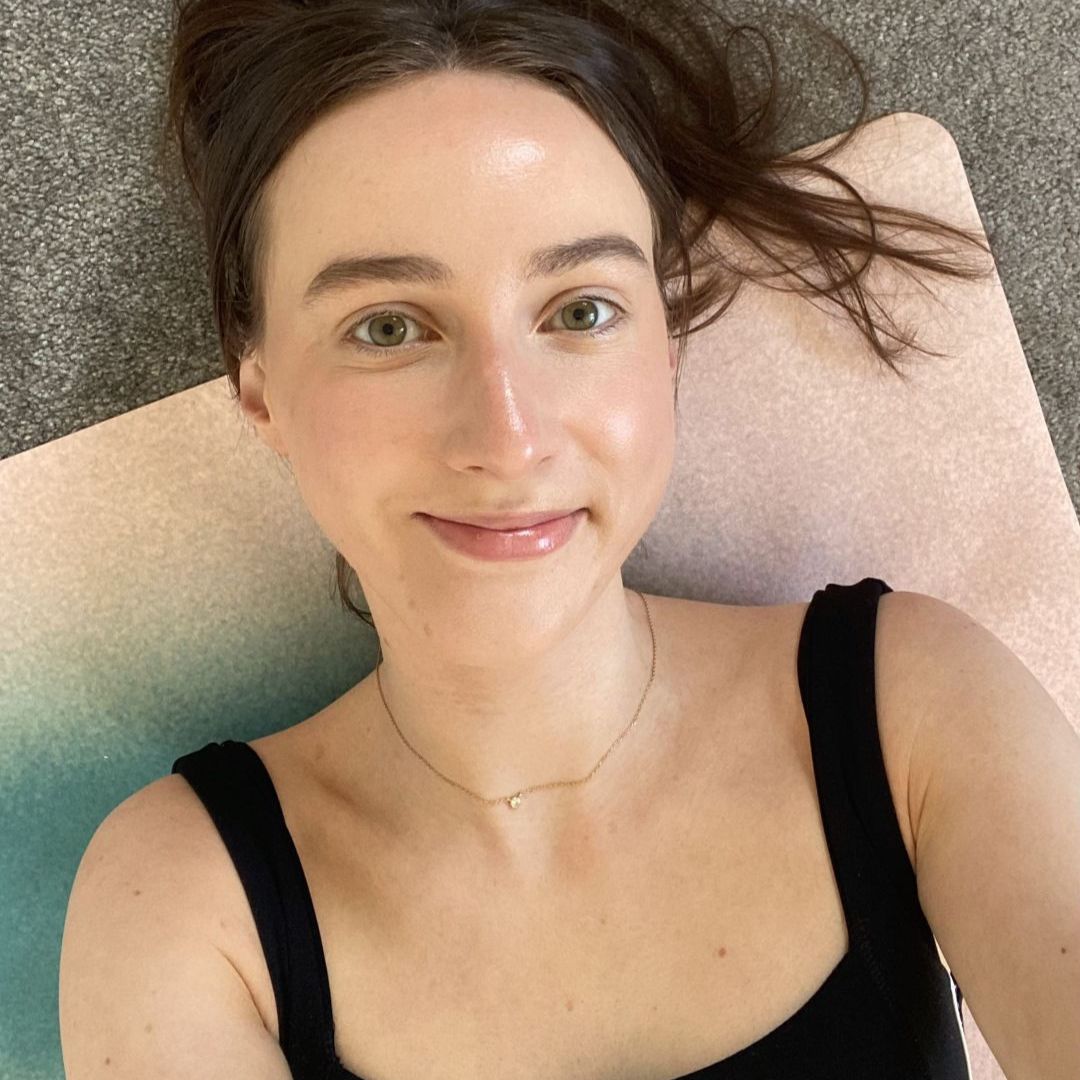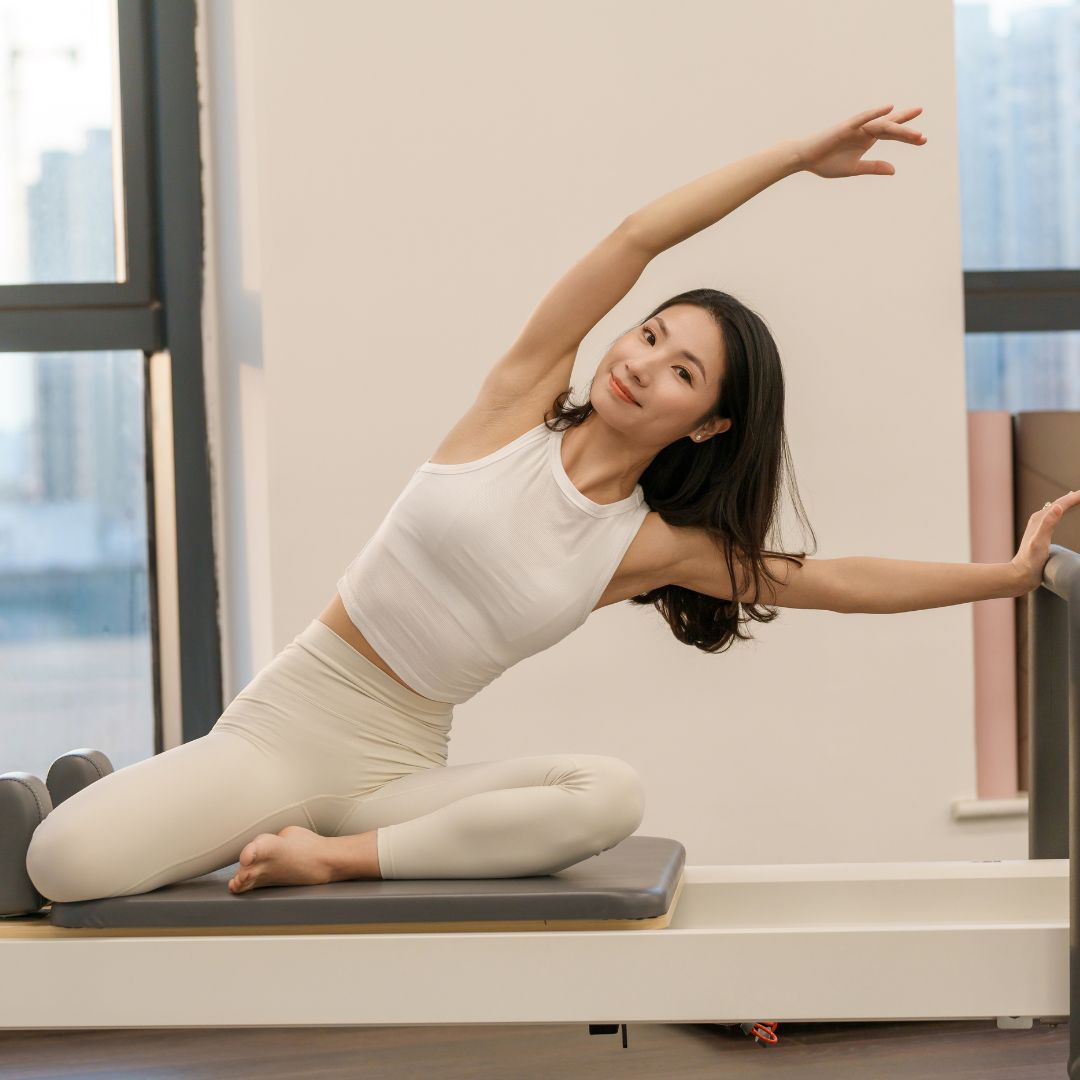A top expert answers - can you do Pilates effectively at home without spending money on equipment?
The question you've all been asking.

When I first started my journalism career at Women's Health magazine, HIIT was the go-to workout of the moment. Every morning, my Instagram feed would be flooded with sweaty gym-goers smashing out burpees and box jumps in snazzy, dimly lit studios. The conception seemed to be that the harder you worked and the more exhausted you felt post-workout, the more effective your session was. But thankfully, opinions have since shifted, and this year, low-impact (yet highly effective) Pilates workouts have taken the top spot.
Search for the workout is at breakout on Google, meaning it's being searched in seriously high volume and more than ever before. Wondering why the previously forgotten form of movement is having such a moment RN? Well, besides the celebrity endorsements (Hailey Bieber, Kendall Jenner and Lori Harvey are regularly papped leaving high-end Pilates studios, and Harry Styles is even said to be a fan), it can be done from anywhere.
There are a whole heap of research-backed examples of the benefits of Pilates - in other words, why it can be so beneficial for both mind and body, too. For starters and as I mentioned above, it's a low impact workout, which means it puts less stress through your ligaments and joints than, say, high intensity training. That's not to say it's less effective, though - you need only search "Pilates results" on TikTok to see the small army of people who've seen a massive physical and mental boost since incorporating leg circles and hundreds into their weekly workout rotation.
You'll know that in-studio Reformer classes are one of the most raved-about styles of the workout, but if the price tag puts you off, you might be considering giving it a go from home. That's where this guide to how to make living room-based sessions actually effective comes in, arming you with the must-try tools for making your Pilates session bang for buck any time, any place.
Keep scrolling for more, and don't miss our guides to the best Pilates exercises, 20 minute Pilates workouts, and 30 minute Pilates workouts, here. If you want to read up on the different types of the sweat session, our guides to wall Pilates, contemporary Pilates, Cadillac Pilates, Tower Pilates and somatic Pilates will come in handy. Or, if you're keen to invest in some kit, scroll our tried and tested edits of the best Pilates bars, best Pilates kit, best Pilates socks and best at-home Reformer Pilates machines.
Keen to learn how to do Pilates effectively at home without equipment? Consider this your failsafe guide
What is mat-based Pilates?
According to Sian French, lead physiotherapist at Bupa UK, mat-based Pilates is, as you might have guessed, a version of the workout but performed on a mat, rather than a Reformer machine. "It's a form of exercise that focuses on strength, balance and posture through a targeted series of full-body exercises, using a mat as the primary surface," she goes on. "This practice emphasises your core stability and engages various muscle groups through controlled movements."
So, what's the main difference between mat-based Pilates and equipment-based Pilates? While you can use equipment, like Pilates rings, and Pilates bands for your mat-based sessions, mat Pilates largely relies on body weight and gravity for resistance, making it accessible for most fitness levels, she goes on.
Marie Claire Newsletter
Celebrity news, beauty, fashion advice, and fascinating features, delivered straight to your inbox!
Do you need equipment to do Pilates at home?
According to French, you don't - and it can be just as effective without it. "Mat-based Pilates focuses on using your body weight for resistance, so you don’t need any of the specialised machines or tools that are used in other forms of Pilates," she shares.
All you need is a flat surfaced area, a mat, or a rug, she recommends.
@carolinecitelli ♬ pastel skies - Rook1e
What are the benefits of doing mat Pilates?
Wondering what the science-backed benefits of practising Pilates at home are over, say, spending money to head in-studio with a trained professional? Of course, you'll have access to more guidance if you're in person with someone who teaches Pilates for a living, and you may even be more accountable if you physically book and pay for a class.
That said, studies have shown that following a traditional mat Pilates programme for eight weeks can improve your range of movement. "This includes how well you can reach, curl up and extend your lower back," explains French. "Plus, the same study found that following this regime can help to reduce body fat and the circumference of your waist, chest and arms."
Not just that, but mat Pilates can promote mindfulness and stress reduction. "The focus on controlled movements and breathing techniques helps individuals cultivate a greater mind-body connection, which can alleviate anxiety and improve mental clarity," she goes on.
7 tips for making mat Pilates at home effective using just your bodyweight and a mat
1. Create a comfortable space
French recommends using a quiet area in your home with enough space to lay out your mat and move freely. "Ensure the space is well-lit and free from distractions to help you focus during your session," she adds.
2. Start with basic exercises
The logic behind this one being, that you'll be able to confidently tackle more advanced moves once you've got the basics nailed. "Begin with foundational mat exercises that require no equipment," shares the expert. "These exercises will help you build your core strength and stability before trying more advanced movements."
Her recommendations include The Hundred, shoulder bridges and toe taps.
3. Follow online classes or videos
By following a qualified trainer's class online, you'll be able to make sure you're utilising your workout time efficiently and further practising correct form for your session. "Online resources, such as video tutorials or guided classes, are a great way to ensure you’re performing exercises correctly," shares the expert. Not just that, but they provide structure and motivation, too, enabling you to tailor the workout to your current fitness level with the guidance of a pro.
Not sure where to start? Our guides to the best Pilates YouTube workouts and best Pilates workouts at home will come in handy here.
@lilliates ♬ U RIGHT X LUXURIOUS - BABY Q
4. Focus on your breathing
Did you know? Breathing is essential when performing Pilates as it not only helps you to activate your muscles, improve your range of motion, and reduce tension but further improves your focus, resulting in a more effective session.
Try this: "Inhale deeply to prepare for movement and exhale as you engage your muscles," recommends French. "This connection will improve the effectiveness of each exercise."
5. Incorporate modifications
If you’re finding any of the exercises in your mat-based Pilates workout challenging, know this: it’s totally fine (and often more effective) to modify them to a level that you can actually perform them. "For example, if The Hundred is too difficult for you, keep your knees bent instead of extending your legs," she advises.
If you do soldier through a workout exercise that doesn't work for you, you actually put yourself of injury or over-compensating your form, resulting in an ineffective move.
Top tip: Remember to always listen to your body and adapt the exercise if necessary to prevent injury, stresses the pro.
6. Establish a routine
You'll likely already know that consistency is essential in any workout routine for building muscle memory and enhancing overall fitness, and Pilates is no different.
French's advice? "Aim to perform regular sessions of mat Pilates alongside 150 minutes of moderate intensity exercise, like brisk walking, each week."
7. Take proper rest breaks
This one might sound counterintuitive to improving your fitness levels, sure, but you'll only be able to grow muscle if you allow adequate time for rest between workouts. "Recovery is vital for muscle growth and overall well-being," shares the pro.
As a basic start point, try each move for 45 seconds at a time and then rest for 15 to 30 seconds.
An expert's go-to mat Pilates moves to try:
1. The Hundred
What? "This foundational exercise builds core strength and endurance," shares the physiotherapist.
How to? Lie on your back with your legs extended at a 45-degree angle. Curl your upper body off the mat and pump your arms up and down while inhaling for five counts and exhaling for five counts.
How long? Repeat for a total of ten rounds to engage your core effectively. Aim for rounds of 45 seconds on, with 15 to 30 seconds rest.
2. Shoulder Bridge
What? This exercise strengthens the glutes and lower back, explains the expert.
How to? Lie on your back with your knees bent and feet flat on the floor. As you curl your tailbone under, lift your hips sequentially off the mat, creating a straight line from shoulders to knees. Hold briefly at the top before rolling back down.
How long? Repeat for a total of ten rounds to engage your core effectively. Aim for rounds of 45 seconds on, with 15 to 30 seconds rest.
3. Ball Roll
What? "This movement enhances balance and coordination while massaging the spine," shares French.
How to? Sit with your knees bent and hold onto your ankles. Roll back onto your shoulder blades, then return to the starting position with control. Aim for six repetitions to promote core stability.
How long? Repeat for a total of ten rounds to engage your core effectively. Aim for rounds of 45 seconds on, with 15 to 30 seconds rest.
4. Single Leg Stretch
What? This exercise mimics traditional Pilates leg movements while enhancing flexibility.
How to? Lie on your back and pull one knee into your chest while extending the opposite leg out at a diagonal. Switch legs in a controlled manner, focusing on engaging the core throughout the movement.
How long? Repeat for a total of ten rounds to engage your core effectively. Aim for rounds of 45 seconds on, with 15 to 30 seconds rest.
5. Swan
What? This exercise strengthens the back muscles and improves posture.
How to? Lie face down with arms extended in front of you. Lift your head, chest, and arms off the mat while keeping your lower body grounded. This small lift helps lengthen and strengthen the spine without requiring equipment.
How long? Repeat for a total of ten rounds to engage your core effectively. Aim for rounds of 45 seconds on, with 15 to 30 seconds rest.
6. Teaser
What? This advanced move challenges both strength and balance.
How to? Lie on your back with your legs extended and arms overhead. Curl up, lifting both legs to form a V shape while reaching your arms forward. Lower back down smoothly to maintain control throughout.
How long? Repeat for a total of ten rounds to engage your core effectively. Aim for rounds of 45 seconds on, with 15 to 30 seconds rest.
7. Swimming
What? This movement promotes strength and coordination.
How to? Lie face down with arms extended in front of you and legs straight behind you. Lift the opposite arm and leg simultaneously in a fluttering motion to engage the entire posterior chain, promoting strength and coordination.
How long? Repeat for a total of ten rounds to engage your core effectively. Aim for rounds of 45 seconds on, with 15 to 30 seconds rest.
Shop MC UK's go-to Pilates kit now:

Adanola's leggings are one of Team MC UK's favourite pairs of workout leggings for a reason - they're an affordable price point but work seriously well for any workout, keeping you cool and dry and sweat-wicking well.

More a fan of shorts for your workouts? The Kardashians are big fans of Alo Yoga, wearing it for Pilates, yoga and more. These biker shorts are butter soft and wash well.

Elevate your workout look with this matching Alo Yoga tank, with a handy built-in bra and supportive straps to help you move with confidence.

If you are keen to invest in some kit to elevate your home sessions, Pilates ankle weights are a great place to start. They come in a range of weights and colourways and add tension to most mat-based moves.

Ally Head is Marie Claire UK's Senior Health and Sustainability Editor, nine-time marathoner, and Boston Qualifying runner. Day-to-day, she heads up all strategy for her pillars, working across commissioning, features, and e-commerce, reporting on the latest health updates, writing the must-read wellness content, and rounding up the genuinely sustainable and squat-proof gym leggings worth *adding to basket*. She also spearheads the brand's annual Women in Sport covers, interviewing and shooting the likes of Mary Earps, Millie Bright, Daryll Neita, and Lavaia Nielsen. She's won a BSME for her sustainability work, regularly hosts panels and presents for events like the Sustainability Awards, and is a stickler for a strong stat, too, seeing over nine million total impressions on the January 2023 Wellness Issue she oversaw. Follow Ally on Instagram for more or get in touch.
-
 Jonathan Anderson is going to Dior Men
Jonathan Anderson is going to Dior MenHis debut collection will be this June
By Mischa Anouk Smith
-
 I'm a 2025 bride and these are the best affordable wedding dresses I've found
I'm a 2025 bride and these are the best affordable wedding dresses I've foundLess than £1,000 but still the height of chic
By Sofia Piza
-
 I haven't worn my hair completely natural for years, but this air-dry styling cream has made me love my waves again
I haven't worn my hair completely natural for years, but this air-dry styling cream has made me love my waves againI will never be without this
By Amelia Yeomans
-
 I tried Pilates roll-downs every day for a week - and was amazed at how quickly it eased years of stiffness
I tried Pilates roll-downs every day for a week - and was amazed at how quickly it eased years of stiffnessConsider my spine more mobile than before.
By Rebecca Shepherd
-
 I tried Pilates scissors, the raved-about Pilates move - and think it's the best combination of stretching and strengthening ever
I tried Pilates scissors, the raved-about Pilates move - and think it's the best combination of stretching and strengthening everTrust me, this one's worth trying.
By Katie Sims
-
 Power walking is the latest trending workout - and it promises to supercharge your health in the simplest way
Power walking is the latest trending workout - and it promises to supercharge your health in the simplest wayKeen to find out more? Step this way...
By Rebecca Shepherd
-
 Eager to build a strong, stable core from home? 7 advanced Pilates core exercises that coaches do themselves
Eager to build a strong, stable core from home? 7 advanced Pilates core exercises that coaches do themselvesStability, strength *and* control? It's a yes from us.
By Anna Bartter
-
 Classical Pilates is raved about worldwide as the most effective type of Pilates you can do - 8 exercises that instructors recommend
Classical Pilates is raved about worldwide as the most effective type of Pilates you can do - 8 exercises that instructors recommendTried, tested and trusted moves.
By Katie Sims
-
 Fan of low-impact sessions? These are officially the 7 best Pilates apps for boosting strength, tone and mood
Fan of low-impact sessions? These are officially the 7 best Pilates apps for boosting strength, tone and moodYou can thank us later.
By Katie Sims
-
 I tried STOTT Pilates at home every day for a week - and I've fallen for the trending workout hook, line and sinker
I tried STOTT Pilates at home every day for a week - and I've fallen for the trending workout hook, line and sinkerYou'll want to give this one a go.
By Katie Sims
-
 Keen to get Reformer results without the hefty price tag? 5 best Pilates boards to upgrade your home workouts
Keen to get Reformer results without the hefty price tag? 5 best Pilates boards to upgrade your home workoutsThey're great for small spaces, too.
By Amelia Yeomans





